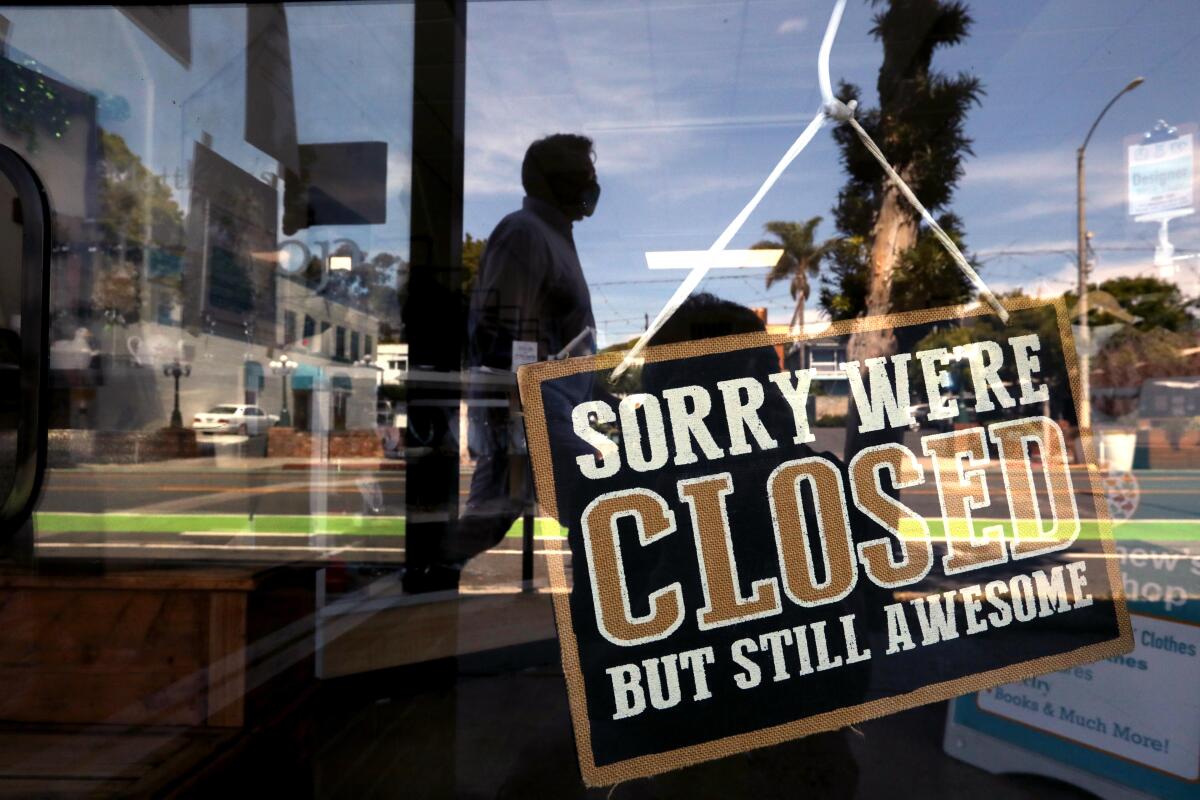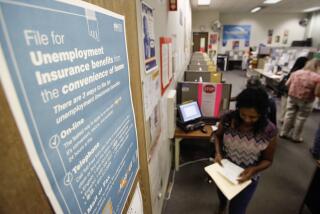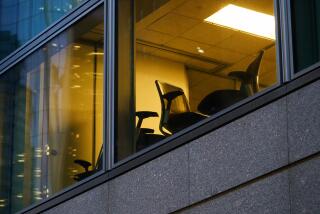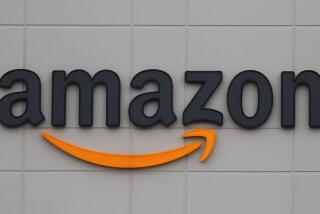Unemployment hits 14.7% in April. How long before 20.5 million lost jobs come back?

- Share via
WASHINGTON — The U.S. economy suffered its biggest labor market shock on record last month, as government figures released Friday showed the COVID-19 pandemic erased 20.5 million jobs and sent the nation’s unemployment rate to 14.7%, the highest since at least the 1940s.
As recently as February, the United States had enjoyed record economic expansion and the lowest unemployment in half a century, 3.5%. Not only is that gone, but more bad news is almost certain in the weeks and months ahead.
President Trump regularly trumpeted the pre-pandemic economy. On Friday, he talked about that as in the past.
“We had the greatest economy in the history of the world,” he said at a White House meeting with Republican lawmakers. Trump went on to say that “we’re going to have a phenomenal year next year. ... I think it’s going to come back blazing, because there’s tremendous pent-up demand.”
But most economists foresee deep damage and a very slow recovery, with high unemployment well into next year.
Although 18 million of the 23 million total unemployed in April said they were on a temporary layoff, many of those furloughs appear not to have a definite end date, and more could become permanent as the effects of the pandemic continue to spread.
J. Crew, the preppy clothing seller, and Neiman Marcus, the upscale department store chain, filed for bankrupcty protection this week. And there have been many other smaller, less visible cases of companies pushed over the edge by COVID-19, including movie theaters, aviation services, auto supply manufacturers and restaurants. Payroll employment at eating and drinking places was down by 5.5 million in April, accounting for more than a quarter of all job losses last month.
Economists at Stanford and the University of Chicago, drawing on a survey of businesses and historical data, estimated that 42% of pandemic-induced layoffs will end up being permanent. With more than 33 million people having filed for unemployment benefits in the last seven weeks, that’s about 14 million who may have to find new work.
Since businesses began to shut down because of the pandemic in March, when the unemployment rate was 4.4%, large-scale layoffs have affected every sector of the economy. Restaurants, retailers, health services, manufacturers and local governments all made big job cuts in April. And unemployment rates rose sharply higher especially for Latinos, African Americans, teenagers, part-time workers and those without any college education.
That’s one reason why economists expect the recovery to be a slog. “Unfortunately, the people most at risk are the ones who had just gotten back to reasonable employment,” said Carl Tannenbaum, executive vice president at Northern Trust in Chicago. He noted that it took a decade of job gains and economic growth for disadvantaged workers to finally make meaningful gains.
April’s official unemployment rate was by far the highest since record-keeping began in 1948, and the number of job losses last month is unparalleled, wiping out nearly all of the gains in the last decade. A broader government measure of joblessness that includes involuntary part-time workers reached 22.8% last month — close to the peak unemployment of 25% at the height of the Great Depression in the 1930s.
Grasping for reasons to be hopeful, analysts noted that some furloughed workers already are being recalled as more states have begun to relax lockdowns and lift stay-at-home orders that had been imposed to contain the coronavirus.
April employment statistics for states will be released in two weeks. California’s relatively early and aggressive response to the pandemic, coupled with its mix of industries that rely more on tourism, entertainment and international travel and trade, suggests that the state is likely to see proportionately bigger job losses than most of the rest of the nation, at least in the short term. Motion picture and sound recording businesses, for example, shed 216,500 jobs last month in the United States.
Gov. Newsom’s administration projected Thursday that California’s 2020 unemployment rate will be 18%, compared with a peak of 12.3% during the Great Recession.
The governor said that more than 4.3 million Californians have filed new claims for unemployment benefits since March 12. “These numbers are jaw-dropping. It is alarming,” Newsom said. “We’ve never experienced anything like this in our lifetime.”
On the other hand, California’s “tech companies are leading in innovations and services that are going to help people telecommute and help people get the information they need to adapt to the pandemic,” said Stephen Levy, director of the Center for Continuing Study of the California Economy in Palo Alto.
Levy said the state’s strong tech sector, plus its record thus far of limiting the pandemic’s infection and death rates, should give California an advantage in recovering jobs lost, although he added: “But that’s two years from now.”
And it could take longer, depending on the virus and public policies. Many medical experts and government officials expect a second wave of infections as states begin to relax social distancing rules, though the new surge is not likely to show up in the data until late summer or early fall.
Even where businesses are reopening, many are operating only partially, with limits on capacity and relatively few workers on hand. Customer demand remains unknown and start-up expenses may be wasted if new outbreaks occur, forcing another round of shutdowns.
Similarly, many employees are wary of returning when their own safety is uncertain. Polls suggest it may be months before most people are comfortable shopping at a mall, boarding an airplane or visiting restaurants, hotels and other public venues.
And the longer consumers hold back on spending, which accounts for 70% of total U.S. economic activity, the greater the chance that many employers will have cash-flow problems and decide they can’t go on.
“A lot of the recovery is going to depend upon businesses being there to reattach the displaced labor,” said Nicholas Eberstadt, a political economist at the American Enterprise Institute. “And if the regiments aren’t there, the soldiers aren’t going to be able to come back.”
Ezekiel Yu, 23, of Plano, Texas, was working two part-time jobs, at Angelika Film Center & Cafe and Barnes & Noble, before he was laid off from both in March. He said the layoffs were temporary, but he hasn’t heard about a return date from Barnes & Noble, and though Angelika was likely to recall him sometime in July, Yu said he’s not sure he’s ready to go back to work.
“There are more people out and about, and you know, people can be careless. I don’t know. I’m just hesitant about working with that many people,” said Yu, who graduated from the University of Texas two years ago. “I’m not sure what job I can do, if it’s safe.”
Michael Bernick, former director of California’s Employment Development Department, said: “When you reopen the economy, you’ve got to do it with confidence and not with a lot of qualifications. ... And until we have that, I think even a formal reopening of the economy is not going to bring back that many jobs.”
Friday’s grim jobs report was largely expected, but will nonetheless add to the rancorous debate in Washington on what additional policies, if any, are needed in the face of a cratering economy.
Trump revived his call for a payroll tax cut and also mentioned Friday a desire for a reduction in capital gains taxes. Larry Kudlow, Trump’s top economic advisor, lent support for some kind of liability insurance for businesses in light of the risks from the pandemic.
Worker advocacy groups are pushing for an extension beyond July of the $600-per-week federal add-on to unemployment benefits that Congress approved, although some economists said that has incentivized workers not to return to their jobs because many are receiving more than they did in their paychecks.
The extra money in workers’ pockets, however, will help boost demand for goods and services once the economy is back open, economists said.
Susan Houseman, research director at the Upjohn Institute for Employment Research, said one existing pandemic relief measure that could help with employment and that has bipartisan support is so-called work-sharing or short-time unemployment.
Under such a program, an employer avoids layoffs by reducing work hours and paychecks equally for all workers, whose lost pay is temporarily being covered by federal pandemic unemployment aid.
“If you have people in place in their old jobs, the recovery will be faster,” Houseman said, adding that there’s little downside for employer or employee.
As of mid-April, however, work-sharing has had relatively few takers — just 88,447 of 17.76 million Americans receiving jobless payments were participating in work-sharing arrangements. And business groups such as the National Federation of Independent Business have not been promoting the programs.
There’s also broad support among economists and policymakers for Washington to provide more support to states and local governments, which are straining financially as they respond to the healthcare crisis and soaring unemployment.
State budgets have been squeezed from both sides: The economic crash has sent demand for services soaring while it has crushed many states’ main source of revenue, the sales tax.
Times staff writer Patrick McGreevy contributed to this report.
More to Read
Get the L.A. Times Politics newsletter
Deeply reported insights into legislation, politics and policy from Sacramento, Washington and beyond. In your inbox three times per week.
You may occasionally receive promotional content from the Los Angeles Times.











